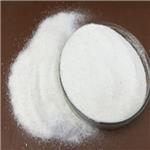1,6-Bis(cyano-guanidino) Hexane--a Biguanide Compound

1,6-Bis(cyano-guanidino) hexane is a biguanide compound which is positively soluble in water and is also a cationic surfactant with excellent antiseptic and broad-spectrum antibacterial activity. It is an important intermediate for the synthesis of biguanides and polyguanides. Widely used in medicines, dyes, explosives, agrochemicals, textiles, plastics production and biotechnology, especially as an antiseptic and antibacterial drug, 1,6-bis(cyano-guanidino) hexane has a good application prospect. Also, it can be applied in chemical medicine, agricultural product protection, food and daily necessities, rubber, plastic vulcanization and promotion auxiliaries.
Structurally, 1,6-bis(cyano-guanidino) hexane is an imidourea or a guanidinium carbamate. Although the content was limited, guanides are found in many plants such as sugar beets, rice husks, mushrooms, and beans in nature. Humans and animals also contain trace amounts of guanides. Increased levels of 1,6-bis(cyano-guanidino) hexane in blood or urine sputum could be induced by some diseases.
Synthesis of 1,6-Bis(cyano-guanidino) hexane: taking n-butanol or a mixture of n-butanol and water as a solvent, hexanediamine hydrochloride and sodium dicyanamide are refluxed at a ratio of 1.0:1.6 to 1.0:2.4 at 100 ° C to 140 ° C. The reaction is carried out for 2 h to 7 h, and after the reaction, the solvent is removed, washed, suction filtered, and dried in vacuo to give a pure 1,6-dicyanodecylhexane compound.
Taking 1,6-bis(cyano-guanidino) hexane as substrate, a kind of environmental protection multi-guanidine polymer sterilizing disinfectant, polyhexamethylene guaidine hydrochloride and phosphate can be prepared. It has strong sterilization, high broad-spectrum, high efficiency, no side effects, and has a long-term bacteriostatic effect. Guanidine groups on the framework had very high activity, and its salt made the polymer positively charged, so it is easy to be adsorbed by various bacteria and viruses which are usually negatively charged. Sterilization is a process that leads to cell death through a series of cytological and physiological changes.
References
1.J. LaDou, International occupational health. Int. J. Hyg. Environ. Health 206(4, 5), 303–313 (2003).
2.J. LaDou, Current Occupational and Environmental Medicine, 4th ed., McGraw-Hill Medical, 2007, pp. 1–846.
3. E. A. Grossman and J. Martonik, OSHA’s approach to risk assessment for setting a revised occupational exposure standard for 1,3-butadiene. Environ. Health Perspect. 86, 155–158 (1990).
See also
Lastest Price from 1,6-Bis(cyano-guanidino)hexane manufacturers

US $6.00/kg2025-04-21
- CAS:
- 15894-70-9
- Min. Order:
- 1kg
- Purity:
- 99%
- Supply Ability:
- 2000KG/Month

US $1000.00-800.00/kg2025-04-21
- CAS:
- 15894-70-9
- Min. Order:
- 1kg
- Purity:
- 99%
- Supply Ability:
- 5000


